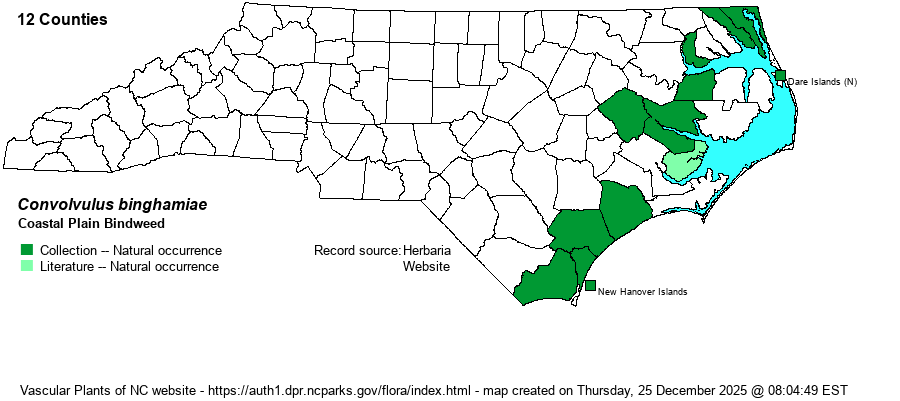| Author | Greene | |
| Distribution | The former Calystegia sepium from RAB (1968) has now been split out into several species, all now in the genus Convolvulus. Thus, many specimens labelled as C. sepium have probably not been annotated or moved into the new species folders at herbaria. The website editors have mapped records in SERNEC named as Calystegia sepium subsp. limnophila, and these fall strictly in the lower Coastal Plain, mostly close to tidal waters. This species does not seem to be present in the upper Coastal Plain, Piedmont, or mountains.
Weakley (2024) shows the range being a Southern coastal one, present north to eastern NC and south to southern FL and west to TX. | |
| Abundance | Uncommon to infrequent, though the exact abundance is not fully clear owing to taxonomic difficulties. The website editors have suggested a State Rank of S3?, and no Watch List status. | |
| Habitat | Weakley (2024) gives its habitats as "Marshes, woodland edges". The distribution close to the coast suggests that the species occurs along the margins of coastal (maritime) woodlands and thickets, including along marsh edges. The habitat descriptions on the SERNEC portal do suggest these sunny coastal habitats. | |
| Phenology | Probably blooms from May to August, and fruits shortly after flowering. | |
| Identification | Members of the former Calystegia sepium (now Convolvulus) complex -- C. americanus, C. fraterniflorus, C. binghamiae, and species 2 -- all are herbaceous vines that range to about 12 feet long or more, and they are also strongly twining. The large alternate leaves are mostly arrowhead-shaped to triangular, with long tips and heart-shaped or more often squared-off leaf bases. Flowers are mostly in the middle and upper leaf axils and are quite large, funnel-shaped, about 2-3 inches long and across, either white or pink with yellow deep in the throat. C. fraterniflorus differs from the other three by the "margins of the bracts immediately subtending the flower overlapping > 1/2 their length; bracts inflated at base (saccate), the apex usually obtuse; flowers 1-2 per axil" (Weakley 2018) -- versus "margins of the bracts immediately subtending the flowers overlapping at the base only or not at all; bracts mostly flat (or often keeled), the apex usually acute; flowers 1 per axil" in the others. Of this latter group, only C. binghamiae has white flowers, whereas C. americanus and C. species 2 have pink flowers. These latter two are separated by "Leaves with basal lobes rounded or with a single angle, or if with 2 angles then not spreading; plant glabrous or commonly pubescent to tomentose on stem" (Weakley 2018) for C. americanus -- versus "Leaves with lobes with 2 angles, spreading; plant glabrous" for C. species 2. In summary, this is the primary member of the group found in coastal or near-coastal habitats, and it should be identified by its large white flower with yellow in the throat; C. americanus has pink flowers. Where it may overlap in the Coastal Plain with C. fraterniflorus, which also has white flowers, see if it has two flowers in an axil (which only C. fraterniflorus has); otherwise, you need to check the bracts of the flowers. | |
| Taxonomic Comments | Weakley (2022) had this taxon named as Convolvulus limnophilus. See Distribution. This taxon is not recognized by NatureServe.
| |
| Other Common Name(s) | None | |
| State Rank | [S3?] | |
| Global Rank | G4G5T4 [G4] | |
| State Status | | |
| US Status | | |
| USACE-agcp | | |
| USACE-emp | | |

